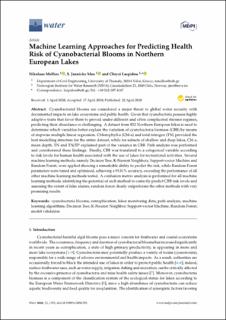| dc.description.abstract | Cyanobacterial blooms are considered a major threat to global water security with documented impacts on lake ecosystems and public health. Given that cyanobacteria possess highly adaptive traits that favor them to prevail under different and often complicated stressor regimes, predicting their abundance is challenging. A dataset from 822 Northern European lakes is used to determine which variables better explain the variation of cyanobacteria biomass (CBB) by means of stepwise multiple linear regression. Chlorophyll-a (Chl-a) and total nitrogen (TN) provided the best modelling structure for the entire dataset, while for subsets of shallow and deep lakes, Chl-a, mean depth, TN and TN/TP explained part of the variance in CBB. Path analysis was performed and corroborated these findings. Finally, CBB was translated to a categorical variable according to risk levels for human health associated with the use of lakes for recreational activities. Several machine learning methods, namely Decision Tree, K-Nearest Neighbors, Support-vector Machine and Random Forest, were applied showing a remarkable ability to predict the risk, while Random Forest parameters were tuned and optimized, achieving a 95.81% accuracy, exceeding the performance of all other machine learning methods tested. A confusion matrix analysis is performed for all machine learning methods, identifying the potential of each method to correctly predict CBB risk levels and assessing the extent of false alarms; random forest clearly outperforms the other methods with very promising results. | en_US |

